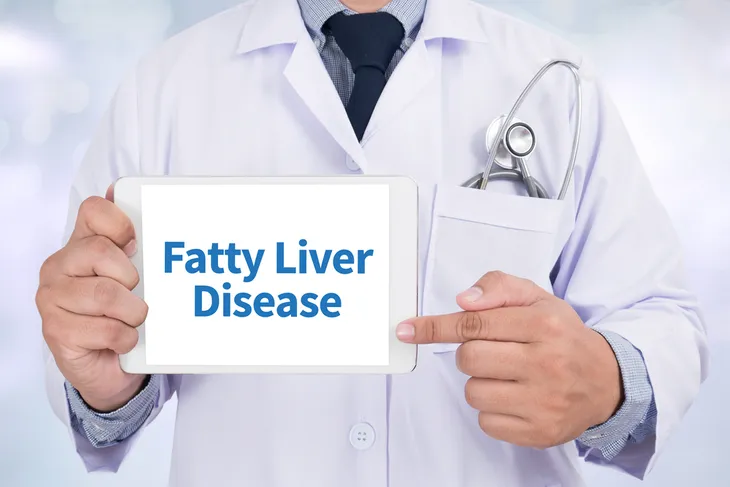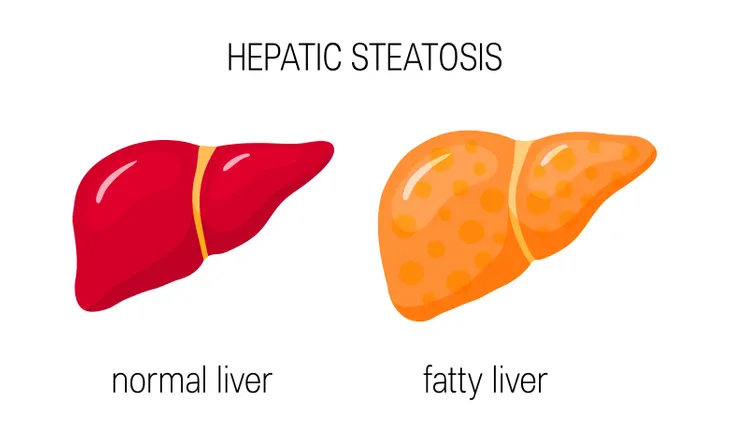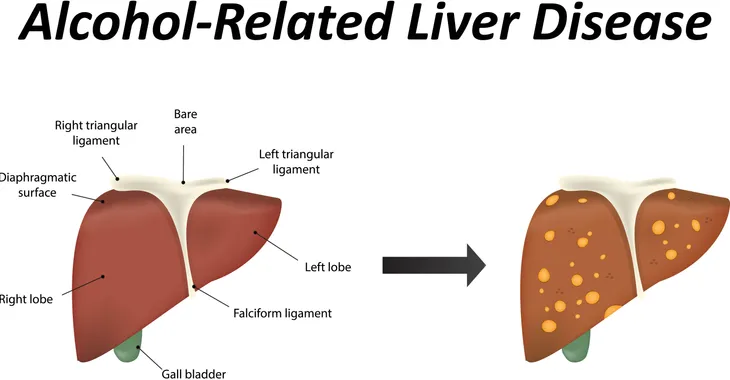The liver is the second largest organ of your body. It plays a vital role in purifying your blood and metabolizing key nutrients in your body. A diseased liver cannot perform these functions well, leading to several health issues. In fact, liver diseases account for almost two million fatalities worldwide. Moreover, fatty liver disease is the most common cause of chronic liver disease in adults.
To better understand fatty liver disease, we break down the key differences between non-alcoholic fatty liver disease and alcohol-related liver disease. Let’s dive in!
What Is Fatty Liver Disease?
As the name indicates, fatty liver disease refers to the excess build-up of fats inside your liver.
A healthy liver carries around 10-percent of fat. Any number beyond this percentage means you have fatty liver disease. This accumulation of excess fat stops your liver from functioning normally, leading to serious health complications.
The two common types of fatty liver disease are non-alcoholic fatty liver disease and alcohol-related fatty liver disease. Let’s explore these in more detail next.
Non-Alcoholic Fatty Liver Disease
Non-alcoholic fatty liver disease (NAFLD) is the most common form of liver disease in the U.S. Almost 30-percent of adult Americans suffer from NAFLD. It is further classified into:
Simple Fatty Liver
Simple fatty liver, also known as steatosis, is when you have fat built up in your cells. Still, there are no inflammatory changes in your liver cells.
As a result, it is less severe and can easily be managed with a healthy diet and weight loss.
Non-Alcoholic Steatohepatitis
Non-alcoholic steatohepatitis (NASH) is more serious than simple fatty liver. It affects 3 to 6-percent of Americans.
NASH happens when you have inflammation inside your liver cells, which leads to liver scarring. NASH can cause more severe consequences, including cirrhosis and liver cancer.
Alcohol-Related Fatty Liver Disease
Heavy drinking leads to the build-up of excess fat inside your liver cells. This condition is known as alcoholic fatty liver disease (ALD). In fact, a 2016 study published in Alcohol Research revealed that 90-percent of people with ALD are those who take four to five drinks a day for several years.
When diagnosed early, ALD can be reversed and managed well. However, ALD can lead to serious and irreversible complications, such as alcoholic hepatitis and alcoholic cirrhosis if you keep drinking heavily.
Symptoms of Non-Alcoholic Fatty Liver Disease
The symptoms of NAFLD are vague and less noticeable. Some people with NAFLD may have no symptoms at all.
Common symptoms of non-alcoholic fatty liver disease are:
- Pain near the upper right side of the abdomen;
- Tiredness;
- Accumulation of fluid around the abdomen;
- Jaundice, and;
- Physical examination reveals enlarged liver.
Symptoms of Alcohol-Related Fatty Liver Disease
ALD results from excessive drinking for years. Over time, alcohol damages the liver and, when left unmanaged, leads to liver cirrhosis.
Typical symptoms of ALD are:
- Nausea;
- Loss of appetite;
- Tiredness;
- Jaundice;
- Abdominal discomfort;
- Abdominal swelling;
- Excessive thirst;
- Swelling in the legs;
- Unexplained weight loss;
- Change in skin tone;
- Dark bowel movements;
- Fainting;
- Mood swings;
- Confusion, and
- Men may have enlarged breasts.
What Causes Non-Alcoholic Fatty Liver Disease?
The exact cause of NAFLD is unclear. However, scientists believe resistance to the hormone that regulates glucose in the body may play a strong role in causing the disease.
Other risk factors include diabetes, high cholesterol, and certain medications.
What Causes Alcoholic Fatty Liver Disease?
Heavy drinking and binge drinking are the most common causes of alcoholic fatty liver disease. In the U.S. alone, alcohol is the leading cause of liver diseases. People with a strong family history of ALD are also at high risk.
Additionally, ALD can lead to a life-threatening condition called acute alcoholic hepatitis. It results from binge drinking in one go.
Who Is At Risk for Non-Alcoholic Fatty Liver Disease?
People with resistance to the hormone that regulates glucose in the body and diabetes are at the highest risk of getting NAFLD. Other risk factors are obesity and high cholesterol.
Since they can’t metabolize fats efficiently, people leading a sedentary lifestyle end up storing excess fat in their liver. Pregnant women are also at a high risk of getting NAFLD.
Are They Preventable?
Simple fatty liver disease and ALD are preventable and even manageable if diagnosed in an early stage. That’s because the liver cells in these diseases somehow remain intact. However, years of heavy drinking can lead to inflammation and scarring of liver cells, making ALD irreversible.
Nevertheless, weight management, healthy eating, and regular screening can prevent all types of fatty liver diseases.
How Are They Diagnosed?
What makes fatty liver disease challenging to diagnose is the lack of symptoms. Most people with a fatty liver don’t have specific symptoms.
To determine if you have fatty liver disease, your health care provider runs a series of tests and assessments. Let’s take a look at these next.
Patient History
Complete health history is an essential attribute in making the correct diagnosis of fatty liver disease. Your doctor will ask you about alcohol intake to figure out whether you have ALD or NAFLD.
Your doctor will also take your medication history and family history of the disease.
Physical Examination and Liver Function Tests
Your doctor will examine you physically to find out if you have an enlarged liver or spleen.
Also known as LFTs, liver function tests check the level of liver enzymes in your blood. In fatty liver disease, these liver enzymes are higher than normal.
Imaging and Liver Biopsy
Imaging tests include ultrasound, CT scan, and/or MRI scan. In fatty liver disease, imaging tests reveal excessive fat deposits in the liver.
Patients with NASH don’t have a history of alcohol abuse but may present with severe symptoms. Your doctor might recommend a liver biopsy as it’s the only way to find out if there’s inflammation and scarring in your liver cells.
Risks of Leaving Alcoholic Fatty Liver Disease Untreated
While ALD is both preventable and curable, leaving it untreated can lead to severe consequences. The most common risk is inflammation, permanent liver scarring, and cirrhosis.
Other risks of leaving ALD are:
- The veins inside your esophagus become enlarged;
- High blood pressure within the veins of the liver;
- Loss of brain function, and;
- In severe cases, patients can develop liver cancer and liver failure.
Non-Alcoholic Fatty Liver Disease Treatment
There is no specific regimen for the treatment of NAFLD. However, based on the severity of your illness, your health care provider will recommend significant lifestyle changes to preserve your liver health.
Since resistance to the hormone that regulates glucose in the body, diabetes, high cholesterol, and a sedentary lifestyle are the most common risk factors for NAFLD, your doctor will recommend:
- A healthy, liver-friendly diet containing plenty of fruits, vegetables, fiber, and whole grains;
- Moderate physical activity of at least 30-minutes a day;
- Weight loss in overweight and obese individuals;
- Weight loss surgery can be considered in extremely obese individuals;
- Avoiding alcohol and drugs that may have side effects on your liver, and;
- Liver transplantation in the case of advanced stages and cirrhosis.
Your doctor will also screen your blood for cholesterol and blood sugar during treatment.
Alcohol-Related Fatty Liver Disease Treatment
Treatment of ALD is aimed at:
- Preserving the liver;
- Preventing further damage, and;
- Reversing inflammation.
Therefore, the first step in the treatment of ALD is to stop drinking. Your doctor will also prescribe multivitamins to treat nutritional deficiencies caused by alcohol abuse.
If the disease has caused prominent scarring of liver tissues, your doctor might suggest a liver transplant.
How to Take Care of Your Liver
Your liver health speaks volumes about your overall body health. Not only does it metabolize nutrients in your body, but it also purifies your blood, eliminating every single toxin from your body. To do so, your liver should be in prime condition.
Some of the ways in which you can keep your liver happy and healthy are:
- Eat a Healthy, Balanced Diet: Diet plays a vital role in maintaining liver health and preventing the progression of fatty liver. The traditional Mediterranean diet containing fiber, whole grains, good fats, and lean meat is great for your liver.
- Maintain a Healthy Weight: Studies have shown overweight and obese people are at a greater risk of having insulin resistance, diabetes, and high cholesterol, which are the key risk factors for fatty liver disease.
- Exercise Regularly: Exercising is a great way to burn calories from fat that stores in your liver. A 2018 study on the effects of exercise on a fatty liver revealed that moderate exercise for 20 to 40-minutes for 4 to 7-days a week helps in improving steatosis and preventing fatty liver disease.
- Avoid Alcohol: Alcohol abuse is associated with liver damage. Try to avoid alcohol as much as you can or talk to your doctor to determine what amount of alcohol is safe for your liver. In the absence of a fatty liver, the U.S. Dietary Guidelines recommend limiting alcohol to one serving per day in women and two servings a day in men.
- Avoid Self-Medication: Most medicines are metabolized through your liver. The more medication you take, the more burden you give to your liver. Avoid taking medicines without a doctor’s prescription.
- Hydration: Drink plenty of water.




















